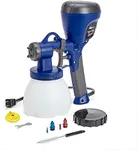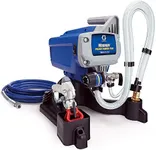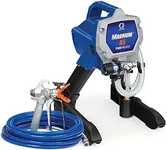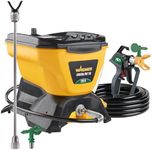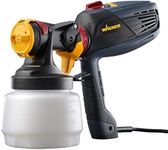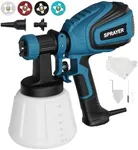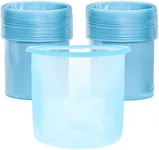Buying Guide for the Best Latex Paint Sprayers
Choosing the right latex paint sprayer can make your painting projects much easier and more efficient. The right sprayer will help you achieve a smooth, even finish and save you time compared to traditional painting methods. When selecting a latex paint sprayer, it's important to consider several key specifications to ensure you pick the best fit for your needs. Here are the main specs to look at and how to navigate them.Type of SprayerThere are three main types of paint sprayers: airless, HVLP (High Volume Low Pressure), and compressed air sprayers. Airless sprayers are great for large surfaces and thick coatings, making them ideal for exterior walls and fences. HVLP sprayers are better for detailed work and fine finishes, such as furniture and cabinets. Compressed air sprayers are versatile but require an air compressor. Choose the type based on the size and detail of your project.
Spray Tip SizeThe spray tip size determines the width and thickness of the paint stream. Smaller tips (0.009-0.013 inches) are suitable for thin materials like stains and lacquers, while larger tips (0.015-0.019 inches) are better for latex paints. For very thick materials, you might need a tip size of 0.021 inches or larger. Match the tip size to the viscosity of the paint and the surface area you are covering.
Flow RateFlow rate, measured in gallons per minute (GPM), indicates how much paint the sprayer can apply in a given time. Higher flow rates are suitable for large projects and can speed up the painting process. For smaller, detailed work, a lower flow rate is more manageable. Consider the scale of your project to determine the appropriate flow rate.
Motor PowerMotor power, usually measured in horsepower (HP), affects the sprayer's ability to handle thicker paints and maintain consistent pressure. More powerful motors (1 HP or higher) are better for heavy-duty tasks and frequent use. For occasional, smaller projects, a less powerful motor (0.5 HP or less) may suffice. Choose based on the frequency and intensity of your painting needs.
Hose LengthThe hose length determines how far you can move around without relocating the sprayer. Longer hoses (50 feet or more) are useful for large areas and exterior projects, while shorter hoses (25 feet or less) are adequate for smaller, indoor tasks. Consider the size of the area you will be painting to decide on the appropriate hose length.
Ease of CleaningCleaning a paint sprayer can be time-consuming, so look for models with features that make this process easier, such as quick-release parts or reversible tips. Some sprayers are designed to be flushed with water or cleaning solutions quickly. If you plan to use the sprayer frequently, ease of cleaning is an important factor to consider.
Weight and PortabilityThe weight and portability of the sprayer can affect your comfort and ease of use, especially for extended periods. Lighter models are easier to maneuver and carry, making them suitable for smaller projects or detailed work. Heavier models may offer more power and capacity but can be cumbersome. Balance the need for power with your ability to handle the sprayer comfortably.
